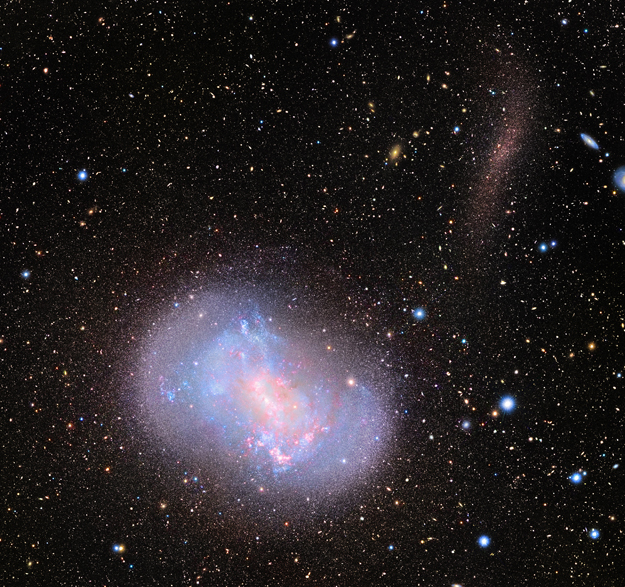Subaru Telescope Captures Images of ‘Stealth Merger’ of Dwarf Galaxies

An international team of scientists led by David Martinez-Delgado (Max Planck Institute for Astronomy, Germany) has conducted research that reveals a “stealth merger” of dwarf galaxies, where an in-falling satellite galaxy is nearly undetectable by conventional means yet has a substantial influence on its host galaxy. Aaron Romanowsky (University of California Observatories in Santa Cruz) along with graduate student Jacob Arnold (UCSC) used the Subaru Telescope to obtain high-resolution images of individual stars in a dense stream of stars in the outer regions of a nearby dwarf galaxy (NGC 4449); these outlying stars are the remains of an even smaller companion galaxy in the process of merging with its host [1].
NGC 4449, the host galaxy, is the smallest primary galaxy in which a stellar stream from an ongoing merger has been identified and studied in detail. Romanowsky commented, “I don’t think I’d ever seen a picture of a galaxy merger where you can see the individual stars. It’s really an impressive image.”
Martinez-Delgado organized a campaign to follow up on an initial report of the stellar stream in NGC 4449, first detected by Russian astronomers as a mysterious, faint smudge in digitized photographic plates from the Digitized Sky Survey project. Had the objects been slightly fainter, more diffuse, or farther from the host galaxy, the stellar stream could easily have been missed. NGC 4449 is located 12.5 million light-years from Earth and is a member of a group of galaxies in the constellation Canes Venatici. Martinez-Delgado recruited astrophotographer Jan GaBany (recipient of the 2010 AAS Chambliss Amateur Achievement Award) to obtain deep, wide-field images with the half-meter telescope at Black Bird Observatory; these images confirmed the presence of a faint substructure in the galaxy’s halo. Romanowsky and Arnold then took advantage of the wide field of view and light collecting power of Subaru Telescope’s 8.2 meter mirror and its prime focus camera (Suprime-Cam) to capture high resolution images of the faint objects in the halo. These final observations at Subaru in 2011 clearly showed the stealth merger of two dwarf galaxies.
Modern cosmological theory posits that large galaxies were built up from smaller ones through an orderly succession of mergers. Although astronomers have observed many mergers involving massive galaxies, it has been difficult to find mergers of two dwarf galaxies. Theory suggests that similar processes of merging should occur on a smaller scale, with small galaxies eating even smaller ones; this is how galaxies grow. Romanowsky commented on the significance of the Subaru image: “Now we have this beautiful image of a dwarf galaxy consuming a smaller dwarf. You can see a smaller galaxy coming in and getting shredded, eventually leaving its stars scattered through the halo of the host galaxy.”
The new observations support the idea that the stellar halos around many dwarf galaxies are the remnants of smaller satellites that were shredded in past merger events. The ongoing merger in NGC 4449 may also be responsible for the intense burst of star formation seen in the galaxy. “This galaxy is famous for its starburst activity, and it seems we’ve found the reason for that. The gravitational interaction with the incoming galaxy has probably disturbed the gas in the main galaxy and caused it to start forming stars,” Romanowsky said.
Notes
1. The companion galaxy was also independently discovered by a team of scientists led by UCLA astronomer Michael Rich. Their study, based on images obtained by the Centurion 28-inch telescope located at the Polaris Observatory Association near Frazier Park, California, will be published in the February 9th issue of Nature.
2. To see the image that accompanies this text, please click on the following link: subarutelescope.org/Pressrelease/2012/02/08/fig.jpg
3. This research was supported by the National Science Foundation (NSF, USA), National Aeronautics and Space Administration (NASA, USA) and the University of California at Santa Cruz -University Affiliated Research Center (UCSC-UARC) Aligned Research Program.
4. The paper describing the research, “Dwarfs gobbling dwarfs: A stellar tidal stream around NGC 4449 and hierarchical galaxy formation on small scales”, will be published in Astrophysical Journal Letters. Coauthors of this international study: D. Martinez-Delgado (Max Planck Institute for Astronomy, Germany); A. Romanowsky (University of California Observatories at Santa Cruz, USA); J. Arnold (University of California at Santa Cruz, USA); R. J. GaBany (astrophotographer, amateur astronomer, USA); J. Brodie (UC Santa Cruz, USA); F. Annibali (Astronomical Observatory of Bologna, Italy); J. Fliri (Observatory of Paris, France); S. Zibetti (University of Copenhagen, Denmark); R. van der Marel (Space Telescope Science Institute, USA); A. Aloisi (Space Telescope Science Institute, USA); H.-W. Rix (Max Planck Institute for Astronomy, Germany); A. Maccio (Max Planck Institute for Astronomy, Germany); T. Chonis (University of Texas at Austin, USA); J. Carballo-Bello (Canary Astrophysics Institute, Spain); J. Gallego-Laborda (Fosca Nit Observatory Spain); M. Merrifield (University of Nottingham, UK).
PIO Contact:
Suzanne Frayser
Subaru Telescope, Hilo, HI, USA
frayser@naoj.org
+1-808-934-5022
Science Contact:
Aaron Romanowsky
University of California Observatories in Santa Cruz, USA
romanow@ucolick.org
+1-831-459-3281
Text & Images:
http://subarutelescope.org/Pressrelease/2012/02/08/index.html









